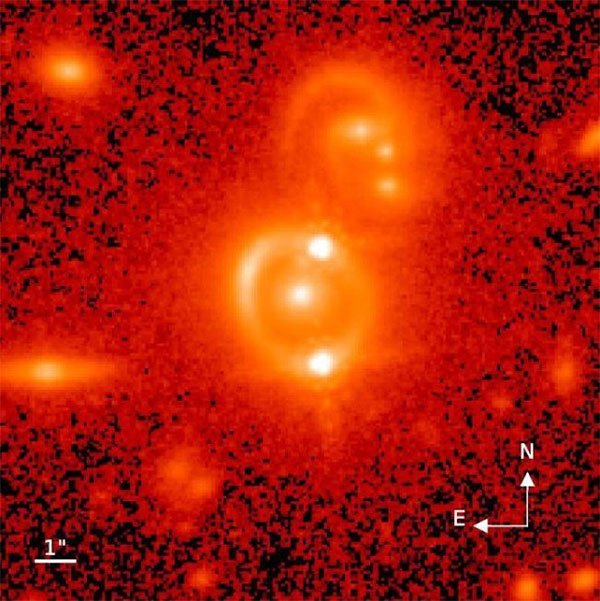11 mysterious objects in the universe that humans cannot explain
The double quasar, the dwarf planet Haumea or the Tabby star all have mysteries that astronomers have not yet answered.

In September 2018, scientists from NASA discovered a stream of infrared light coming from a neutron star 800 light-years from Earth.This is surprising to astronomers because neutron stars have previously only emitted radio waves and rays with high-energy radiation such as X-rays. (Photo: ESA)

Since 2007, researchers have discovered extremely strong and extremely bright radio signals that last only a few milliseconds, known as fast radio bursts (FRBs) .Recently, scientists also detected a repeated FRB, flashing continuously 6 times.The second signal in that FRB has been seen before.(Photo: NRAO Outreach).

Nuclear pasta is the most powerful form of matter in the universe formed from the remains of a dying star.According to the simulation, the protons and neutrons of a star that died when extremely intense compression will create "ghost waves" ripples in space.(Photo: NASA).

The dwarf planet Haumea is already bizarre with its elongated shape and two moons orbiting around.A day lasts only 4 hours here.It has an orbit of rotation in Neptune's Kuiper belt and is the fastest rotating massive object in the Solar System.In 2017, astronomers discovered the maximum ring orbiting Haumea, likely the result of an ancient collision.(Photo: IAA-CSIC).

Scientists have long asserted the presence of dark matter , the type of matter that accounts for 85% of matter in the universe.Until March 2018, the discovery of a galaxy that did not seem to have any dark matter surprised the scientists.The researchers hypothesized that this galaxy was made up of gas released when the other two galaxies merged into one, or that something erased all dark matter from it.(Photo: NASA).

When talking about the oddity of the moons in the Solar System, people often think of the giant volcano Moon of Jupiter, Triton of Neptune. But the most special is the Hyperion Moon - Saturn's natural satellite has an unusual appearance with many deep-impact craters that look like giant pumice stones.NASA's Cassini spacecraft, which explored Saturn from 2004-2017, discovered that the satellite was charged by a beam of electrostatic particles running out into space.(Photo: NASA).

A single neutrino (particles with no charge and almost zero mass) crashed to Earth on September 22, 2017.But not only that, physicists at the IceCube Neutrino Observatory in Antarctica claim to see neutrinos of similar energy levels at least once a month.This helped astronomers discover that 4 billion years ago, a neutrino was thrown to Earth from a quasar around a supermassive black hole in the center of the galaxy that consumes surrounding matter.) Photo: Science Communication Lab).

DGSAT I is a super diffuse galaxy , meaning that even though it is as large as a normal galaxy in the galaxy, its stars are spread out so thin that it is almost invisible (due to the low light). ).According to observations in 2016, the scientists found that DGSAT I was alone, unlike other super diffuse galaxies commonly found in crowded galaxy clusters.Its characteristics suggest that this faint object was formed in the very early age of the universe, about 1 billion years after the Big Bang.In other words, DGSAT I is a living fossil that still exists today.(Photo: Romanowsky).

Twin quasars are two giant objects that can bend light, enough to distort the images behind them.When scientists discovered a quasar from the early universe through the Hubble telescope, scientists used it to estimate the rate of expansion of the universe and found that it was expanding faster than before - a negative finding re-measures existing measurements.(Photo: NASA Hubble Space Telescope).

Wandering planets are objects that are pulled away from their parent planet by their own gravity.Scientists have found in the cluster of wandering planets a planet-sized object, SIMP J01365663 + 0933473, which has a magnetic field 200 times stronger than Jupiter, enough to create aurora flickering in the bulb. The atmosphere can be viewed from Earth using a radio telescope.(Photo: NRAO).

When astronomer Tabetha Boyajian of Louisiana State University and her colleagues first saw the star called KIC 846285, they were shocked. Nicknamed Tabby , this object loses brightness at irregular intervals, sometimes by as much as 22% brightness, making its surface look like a tabby cat.Various theories have been put forward, including the possibility that an alien's infrastructure may be covering the surface.Today, most researchers believe that the star is surrounded by an irregular ring of dust that causes patches of darkness.(Photo: SentientDevelopments).
- NASA accidentally "revealed" videos of 3 mysterious objects leaving Earth
- The mysterious universe makes science "give up"
- The mysteries of the suspect are alien spacecraft under the Baltic Sea
- Glaciers melt to reveal mysterious objects
- Specialist in front of mysterious UFO in New York
- 8 natural scientific phenomena cannot explain
- Top 10 most hilarious mysteries of all time
- Mysterious objects fall into Myanmar
- The mysterious object will fall to Earth tonight
- Interstellar objects spread life from Earth into the universe
- Evolution in mice can explain infertility in humans
- The metal sphere fell after the explosion that panicked the Peruvian people
- The mysterious 'spooky' series in the ocean
- Detecting mysterious light is said to be UFO in Lon Don
 Van Allen's belt and evidence that the Apollo 11 mission to the Moon was myth
Van Allen's belt and evidence that the Apollo 11 mission to the Moon was myth The levels of civilization in the universe (Kardashev scale)
The levels of civilization in the universe (Kardashev scale) Today Mars, the sun and the Earth are aligned
Today Mars, the sun and the Earth are aligned The Amazon owner announced a secret plan to build a space base for thousands of people
The Amazon owner announced a secret plan to build a space base for thousands of people